Novel Fibre-Rich Breads Yield Improved Glucose Release Curves and Are Well Accepted by Children in Primary School Breakfast Clubs
Abstract
1. Introduction
2. Materials and Methods
2.1. Study 1: In Vitro Digestion of Breads
2.1.1. Materials—Study 1
2.1.2. In Vitro Gastrointestinal Digestion
2.1.3. Sampling and Glucose Detection
2.2. Study 2: Acceptability in School Breakfast Clubs: A Feasibility Study
2.2.1. Materials—Study 2
- A ‘BARLEYmax® High Fibre’ bread, very high in fibre (3.97 g/slice, 11.3 g/100 g), but with a light visual aspect. Somewhat ‘bitty’ due to barley flakes.
- A ‘Heritage Spelt’ bread with no bits/seeds. Source of fibre (1.44 g/slice, 4.1 g/100 g).
- A ‘Protein Powered’ bread fortified with legumes, close to white and with only very small visible ‘bits’. Source of fibre (2.03 g/slice, 5.8 g/100 g).
- A ‘Sprouted Multiseed’ bread, high in fibre (2.35 g/slice, 6.7 g/100 g), and seeded, with a darker visual aspect.

- Rice Krispies Multigrain Shapes (Strawberry and Apple)—a 30 g serving has 4.8 g of fibre and 2.3 g of sugars
- Rice Krispies Multigrain Shapes (Honey)—a 30 g serving has 3.6 g of fibre and 3.0 g of sugars
- Raisin Wheats—a 30 g serving has 2.7 g of fibre and 3.9 g of sugars
2.2.2. Methods
3. Results
3.1. Study 1: In Vitro Digestion
3.2. Study 2: Acceptability in School Breakfast Clubs
- Magic Breakfast’s standard range was a relatively high-fibre baseline, reflecting their deliberate efforts to increase the fibre density of their offer. The intervention foods therefore often replaced alternatives with an already-high fibre content.
- The baseline variability was relatively high between research days (primarily but not exclusively due to presence/absence of bagels), so individual comparisons may be misleading.
- There were some quite clear (positive) novelty effects. This bodes well for introducing novel foods to breakfast clubs, but also adds a confounding factor to our results.
3.2.1. Breads/Toast with Plant-Based Spread
3.2.2. Ready-to-Eat Breakfast Cereals (With Optional Milk)
3.2.3. Low-Fibre Cereals Augmented with Strawberries and Porridge Oats
4. Discussion
5. Conclusions
Supplementary Materials
Author Contributions
Funding
Institutional Review Board Statement
Informed Consent Statement
Data Availability Statement
Acknowledgments
Conflicts of Interest
References
- Barber, T.M.; Kabisch, S.; Pfeiffer, A.F.H.; Weickert, M.O. The Health Benefits of Dietary Fibre. Nutrients 2020, 12, 3209. [Google Scholar] [CrossRef] [PubMed]
- Public Health England. NDNS: Results from Years 9 to 11 (2016 to 2017 and 2018 to 2019). UK Gov. 2020. Available online: https://www.gov.uk/government/statistics/ndns-results-from-years-9-to-11-2016-to-2017-and-2018-to-2019 (accessed on 14 May 2024).
- Boyle, N.B.; Adolphus, K.; Caton, S.J.; Croden, F.C.; Dye, L.; Glass, A.; Halliwell, K.; Hansen, G.L.; Holm, L.; Jackson, P.; et al. Increasing fibre intake in the UK: Lessons from the Danish Whole Grain Partnership. Br. J. Nutr. 2024, 131, 672–685. [Google Scholar] [CrossRef] [PubMed]
- Gibson-Moore, H.; Spiro, A.; Stanner, S. No food for thought–How important is breakfast to the health, educational attainment and wellbeing of school-aged children and young people? Nutr. Bull. 2023, 48, 458–481. [Google Scholar] [CrossRef] [PubMed]
- Adolphus, K.; Lawton, C.L.; Dye, L. The Effects of Breakfast on Behavior and Academic Performance in Children and Adolescents. Front. Hum. Neurosci. 2013, 7. Available online: http://journal.frontiersin.org/article/10.3389/fnhum.2013.00425/abstract (accessed on 7 May 2024). [CrossRef]
- Adolphus, K.; Lawton, C.L.; Champ, C.L.; Dye, L. The Effects of Breakfast and Breakfast Composition on Cognition in Children and Adolescents: A Systematic Review. Adv. Nutr. 2016, 7, 590S–612S. [Google Scholar] [CrossRef] [PubMed]
- Nelson, M. School food cost–benefits: England. Public Health Nutr. 2013, 16, 1006–1011. [Google Scholar] [CrossRef]
- Agostoni, C.; Brighenti, F. Dietary Choices for Breakfast in Children and Adolescents. Crit. Rev. Food Sci. Nutr. 2010, 50, 120–128. [Google Scholar] [CrossRef] [PubMed]
- Lockyer, S.; Spiro, A. The role of bread in the UK diet: An update. Nutr. Bull. 2020, 45, 133–164. [Google Scholar] [CrossRef]
- Halliday, S. Our Troubles with Food: Fears, Fads and Fallacies; The History Press: Cheltenham, UK, 2009; ISBN 0-7524-9627-1. [Google Scholar]
- Norton, V.; Wagstaff, C.; Rodriguez Garcia, J.; Lovegrove, A.; Shewry, P.; Charlton, M.; Gillett, N.; Tindall, M.J.; Lignou, S. “WAIT, do I need more fibre?” Exploring UK consumers’ dietary fibre-related awareness and white bread as a viable solution to promote subsequent intake. Curr. Dev. Nutr. 2024, 8, 104430. [Google Scholar] [CrossRef] [PubMed]
- Heer, M.; Egert, S. Nutrients other than carbohydrates: Their effects on glucose homeostasis in humans. Diabetes Metab. Res. Rev. 2015, 31, 14–35. [Google Scholar] [CrossRef]
- Goff, H.D.; Repin, N.; Fabek, H.; El Khoury, D.; Gidley, M.J. Dietary fibre for glycaemia control: Towards a mechanistic understanding. Bioact. Carbohydr. Diet. Fibre 2018, 14, 39–53. [Google Scholar] [CrossRef]
- Van Kleef, E.; Vrijhof, M.; Polet, I.A.; Vingerhoeds, M.H.; De Wijk, R.A. Nudging children towards whole wheat bread: A field experiment on the influence of fun bread roll shape on breakfast consumption. BMC Public Health 2014, 14, 906. [Google Scholar] [CrossRef]
- Chow, C.Y.; Skouw, S.; Bech, A.C.; Olsen, A.; Bredie, W.L.P. A review on children’s oral texture perception and preferences in foods. Crit. Rev. Food Sci. Nutr. 2024, 64, 3861–3879. [Google Scholar] [CrossRef] [PubMed]
- Chow, C.Y.; Bech, A.C.; Sørensen, H.; Olsen, A.; Bredie, W.L.P. Food texture preferences in early childhood: Insights from 3–6 years old children and parents. Food Qual. Prefer. 2024, 113, 105063. [Google Scholar] [CrossRef]
- Chow, C.Y.; Bech, A.C.; Olsen, A.; Keast, R.; Russell, C.G.; Bredie, W.L.P. Oral size perception and texture preferences for particle-containing foods in children aged 5–12. J. Texture Stud. 2024, 55, e12848. [Google Scholar] [CrossRef] [PubMed]
- Hörmann-Wallner, M.; Krause, R.; Alfaro, B.; Jilani, H.; Laureati, M.; Almli, V.L.; Sandell, M.; Sandvik, P.; Zeinstra, G.G.; Methven, L. Intake of Fibre-Associated Foods and Texture Preferences in Relation to Weight Status Among 9–12 Years Old Children in 6 European Countries. Front. Nutr. 2021, 8, 633807. [Google Scholar] [CrossRef] [PubMed]
- Donin, A.S.; Goldsmith, L.P.; Sharp, C.; Wahlich, C.; Whincup, P.H.; Ussher, M.H. Identifying barriers and facilitators to increase fibre intakes in UK primary school children and exploring the acceptability of intervention components: A UK qualitative study. Public Health Nutr. 2024, 27, e59. [Google Scholar] [CrossRef] [PubMed]
- Lal, M.K.; Singh, B.; Sharma, S.; Singh, M.P.; Kumar, A. Glycemic index of starchy crops and factors affecting its digestibility: A review. Trends Food Sci. Technol. 2021, 111, 741–755. [Google Scholar] [CrossRef]
- Cooper, S.B.; Bandelow, S.; Nute, M.L.; Morris, J.G.; Nevill, M.E. Breakfast glycaemic index and cognitive function in adolescent school children. Br. J. Nutr. 2012, 107, 1823–1832. [Google Scholar] [CrossRef]
- Blaak, E.E.; Antoine, J.-M.; Benton, D.; Björck, I.; Bozzetto, L.; Brouns, F.; Diamant, M.; Dye, L.; Hulshof, T.; Holst, J.J.; et al. Impact of postprandial glycaemia on health and prevention of disease. Obes. Rev. 2012, 13, 923–984. [Google Scholar] [CrossRef]
- Guleria, S. Food, Obesity, and Noncommunicable Diseases. J. Postgrad. Med. Educ. Res. 2021, 55, 8–11. [Google Scholar] [CrossRef]
- Spieth, L.E.; Harnish, J.D.; Lenders, C.M.; Raezer, L.B.; Pereira, M.A.; Hangen, S.J.; Ludwig, D.S. A Low–Glycemic Index Diet in the Treatment of Pediatric Obesity. Arch. Pediatr. Adolesc. Med. 2000, 154, 947. [Google Scholar] [CrossRef] [PubMed]
- Peres, M.; Costa, H.S.; Silva, M.A.; Albuquerque, T.G. The Health Effects of Low Glycemic Index and Low Glycemic Load Interventions on Prediabetes and Type 2 Diabetes Mellitus: A Literature Review of RCTs. Nutrients 2023, 15, 5060. [Google Scholar] [CrossRef]
- Argyri, K.; Athanasatou, A.; Bouga, M.; Kapsokefalou, M. The Potential of an in Vitro Digestion Method for Predicting Glycemic Response of Foods and Meals. Nutrients 2016, 8, 209. [Google Scholar] [CrossRef]
- Peng, X.; Liu, H.; Li, X.; Wang, H.; Zhang, K.; Li, S.; Bao, X.; Zou, W.; Yu, W. Predicting the Glycemic Index of Biscuits Using Static In Vitro Digestion Protocols. Foods 2023, 12, 404. [Google Scholar] [CrossRef] [PubMed]
- Dupont, D.; Alric, M.; Blanquet-Diot, S.; Bornhorst, G.; Cueva, C.; Deglaire, A.; Denis, S.; Ferrua, M.; Havenaar, R.; Lelieveld, J.; et al. Can dynamic in vitro digestion systems mimic the physiological reality? Crit. Rev. Food Sci. Nutr. 2019, 59, 1546–1562. [Google Scholar] [CrossRef] [PubMed]
- Borczak, B.; Sikora, M.; Sikora, E.; Dobosz, A.; Kapusta-Duch, J. Glycaemic index of wheat bread. Starch Stärke 2018, 70, 1700022. [Google Scholar] [CrossRef]
- Allen, H.F.; Jeffers, B.W.; Klingensmith, G.J.; Chase, H.P. First-phase insulin release in normal children. J. Pediatr. 1993, 123, 733–738. [Google Scholar] [CrossRef] [PubMed]
- Hoyland, A.; Dye, L.; Lawton, C.L. A systematic review of the effect of breakfast on the cognitive performance of children and adolescents. Nutr. Res. Rev. 2009, 22, 220–243. [Google Scholar] [CrossRef] [PubMed]
- Jenkins, D.J.; Wolever, T.M.; Taylor, R.H.; Barker, H.; Fielden, H.; Baldwin, J.M.; Bowling, A.C.; Newman, H.C.; Jenkins, A.L.; Goff, D.V. Glycemic index of foods: A physiological basis for carbohydrate exchange. Am. J. Clin. Nutr. 1981, 34, 362–366. [Google Scholar] [CrossRef]
- Holst, J.J.; Gribble, F.; Horowitz, M.; Rayner, C.K. Roles of the Gut in Glucose Homeostasis. Diabetes Care 2016, 39, 884–892. [Google Scholar] [CrossRef] [PubMed]
- Brodkorb, A.; Egger, L.; Alminger, M.; Alvito, P.; Assunção, R.; Ballance, S.; Bohn, T.; Bourlieu-Lacanal, C.; Boutrou, R.; Carrière, F.; et al. INFOGEST static in vitro simulation of gastrointestinal food digestion. Nat. Protoc. 2019, 14, 991–1014. [Google Scholar] [CrossRef] [PubMed]
- Wilkinson, N.M.; Hetherington, M.M.; Kannan, S.; Ganguri, H.; Evans, C.E.L. High willingness-to-taste in UK children aged 4–7 years was driven by contextual facilitation, not intervention, in a randomized controlled trial of sensory food education. Appetite 2025, 204, 107756. [Google Scholar] [CrossRef]
- Lu, X.; Ma, R.; Zhan, J.; Tian, Y. Structural changes of thermally treated starch during digestion and the impact on postprandial glucose homeostasis. Carbohydr. Polym. 2023, 318, 121105. [Google Scholar] [CrossRef] [PubMed]
- Shao, S.; Yi, X.; Li, C. Main factors affecting the starch digestibility in Chinese steamed bread. Food Chem. 2022, 393, 133448. [Google Scholar] [CrossRef]
- Moretton, M.; Alongi, M.; Melchior, S.; Anese, M. Adult and elderly in vitro digestibility patterns of proteins and carbohydrates as affected by different commercial bread types. Food Res. Int. 2023, 167, 112732. [Google Scholar] [CrossRef]
- Torres, J.D.; Dueik, V.; Carré, D.; Contardo, I.; Bouchon, P. Non-invasive microstructural characterization and in vivo glycemic response of white bread formulated with soluble dietary fiber. Food Biosci. 2024, 61, 104505. [Google Scholar] [CrossRef]
- Lu, X.; Ma, R.; Zhan, J.; Liu, C.; Tian, Y. Starch digestion retarded by wheat protein hydrolysates with different degrees of hydrolysis. Food Chem. 2023, 408, 135153. [Google Scholar] [CrossRef] [PubMed]
- Butler, T.J.; Birman, E.S.; Hancock, N.; Moore, J.B. Sugar Content in UK Breakfast Cereals: A Market Survey. Proc. Nutr. Soc. 2020, 79, E174. [Google Scholar] [CrossRef]
- Ferreira, S.M.; Capriles, V.D.; Conti-Silva, A.C. Inulin as an ingredient for improvement of glycemic response and sensory acceptance of breakfast cereals. Food Hydrocoll. 2021, 114, 106582. [Google Scholar] [CrossRef]
- Oyebode, O.; Gordon-Dseagu, V.; Walker, A.; Mindell, J.S. Fruit and vegetable consumption and all-cause, cancer and CVD mortality: Analysis of Health Survey for England data. J. Epidemiol. Community Health 2014, 68, 856–862. [Google Scholar] [CrossRef] [PubMed]
- Meynier, A.; Chanson-Rollé, A.; Riou, E. Main Factors Influencing Whole Grain Consumption in Children and Adults—A Narrative Review. Nutrients 2020, 12, 2217. [Google Scholar] [CrossRef]
- The Labour Party Labour’s Child Health Action Plan will Create the Healthiest Generation of Children Ever. 2024. The Labour Party; 2024. Available online: https://labour.org.uk/updates/stories/labours-child-health-action-plan-will-create-the-healthiest-generation-of-children-ever/ (accessed on 24 September 2024).
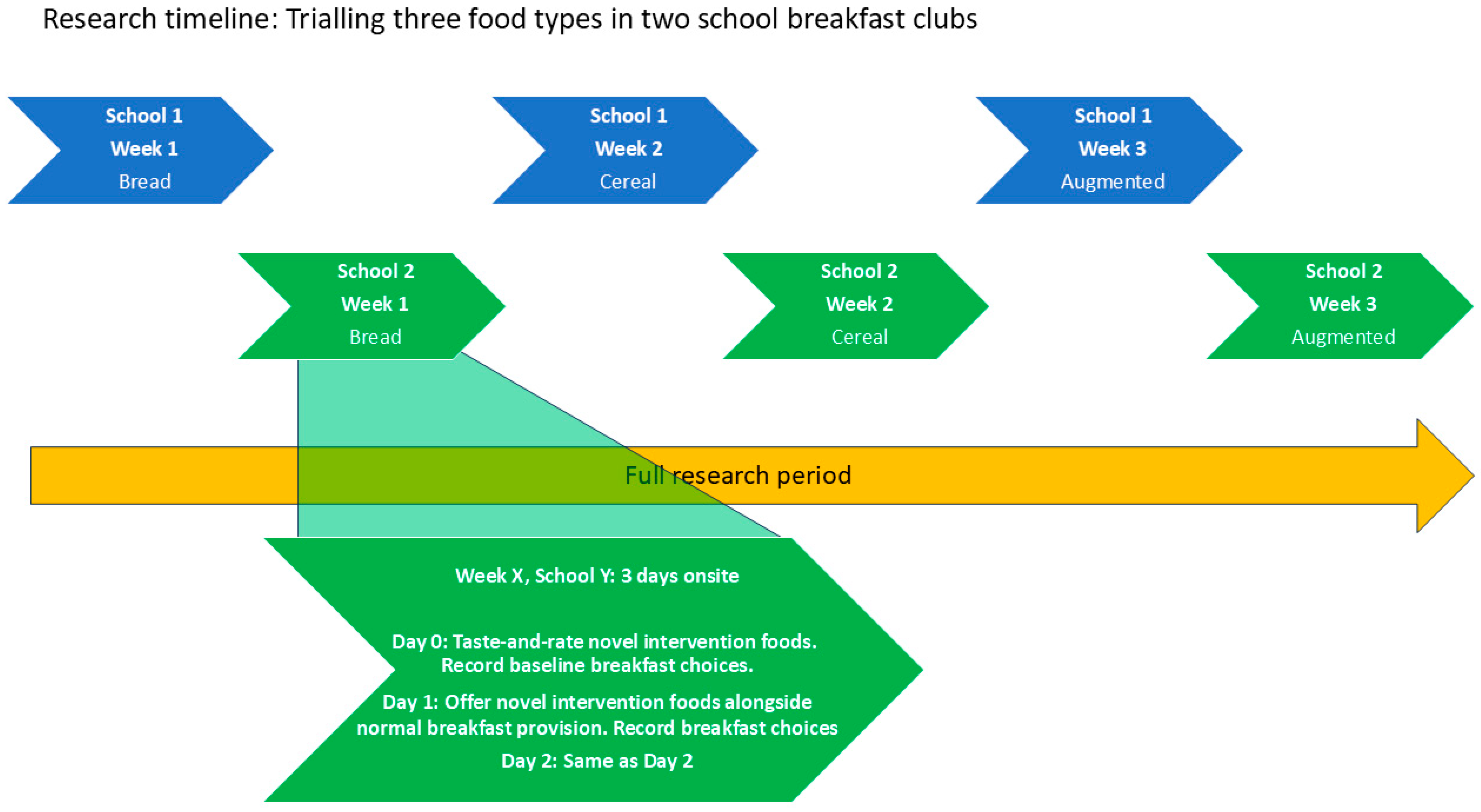
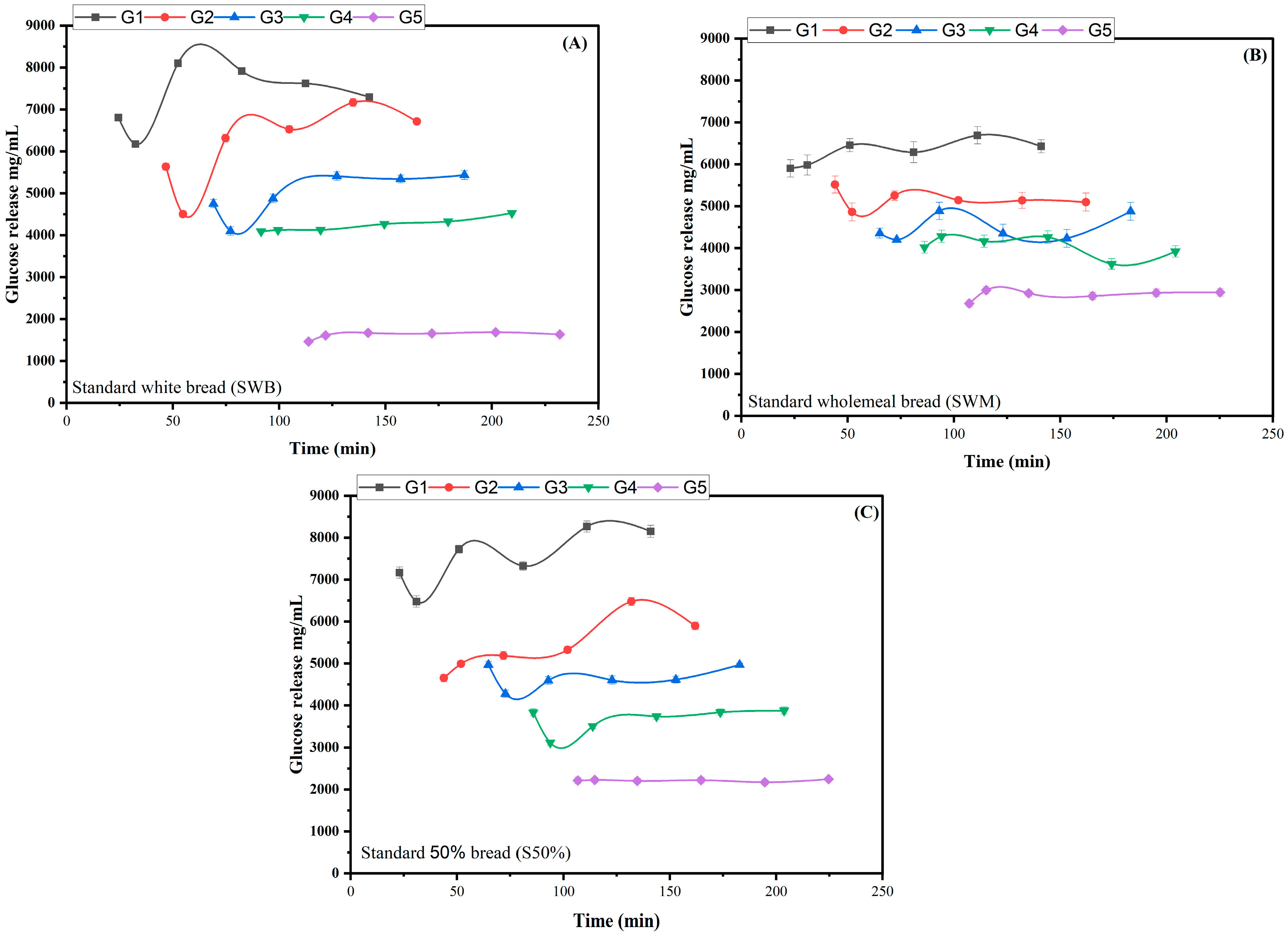
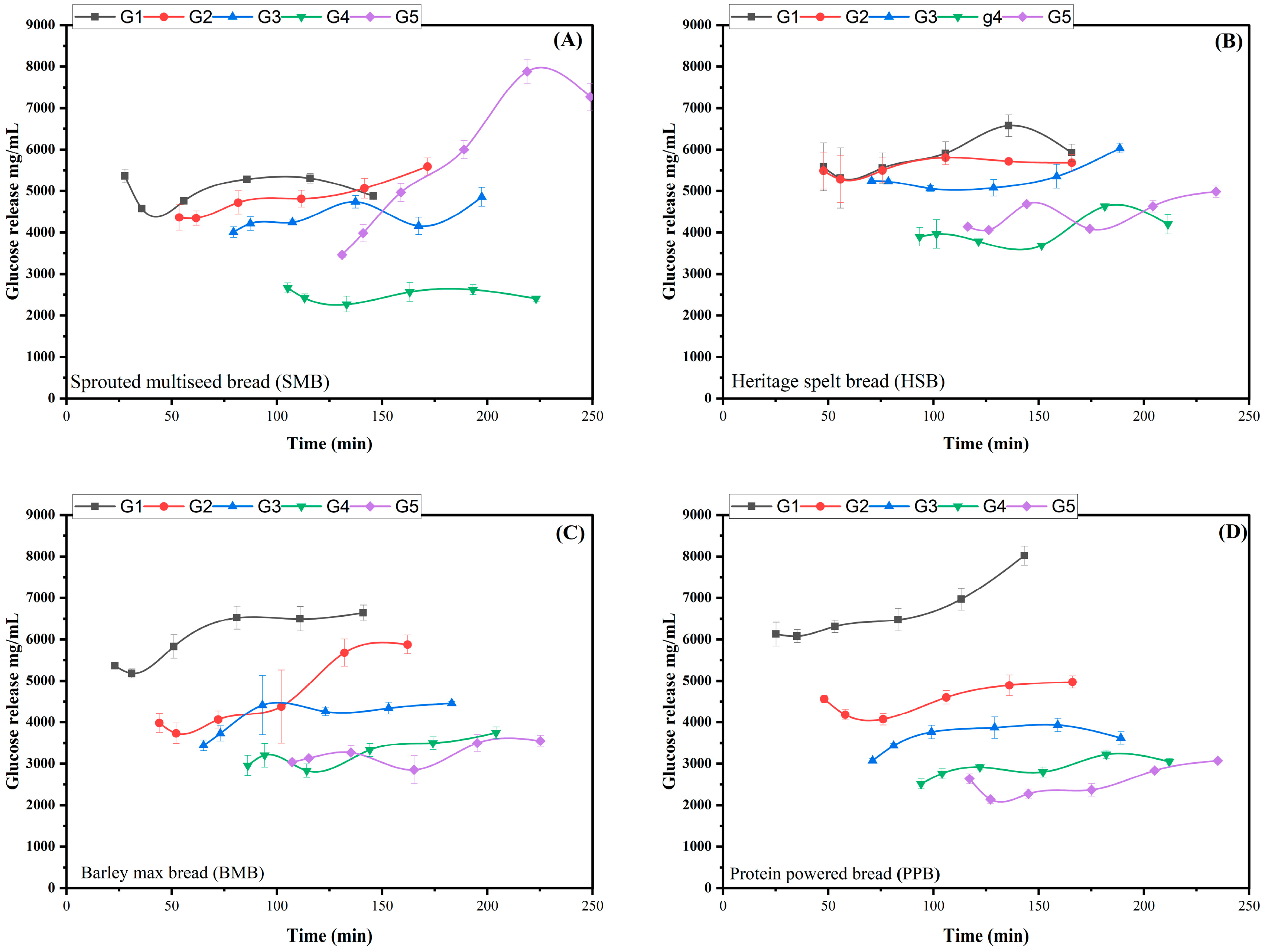
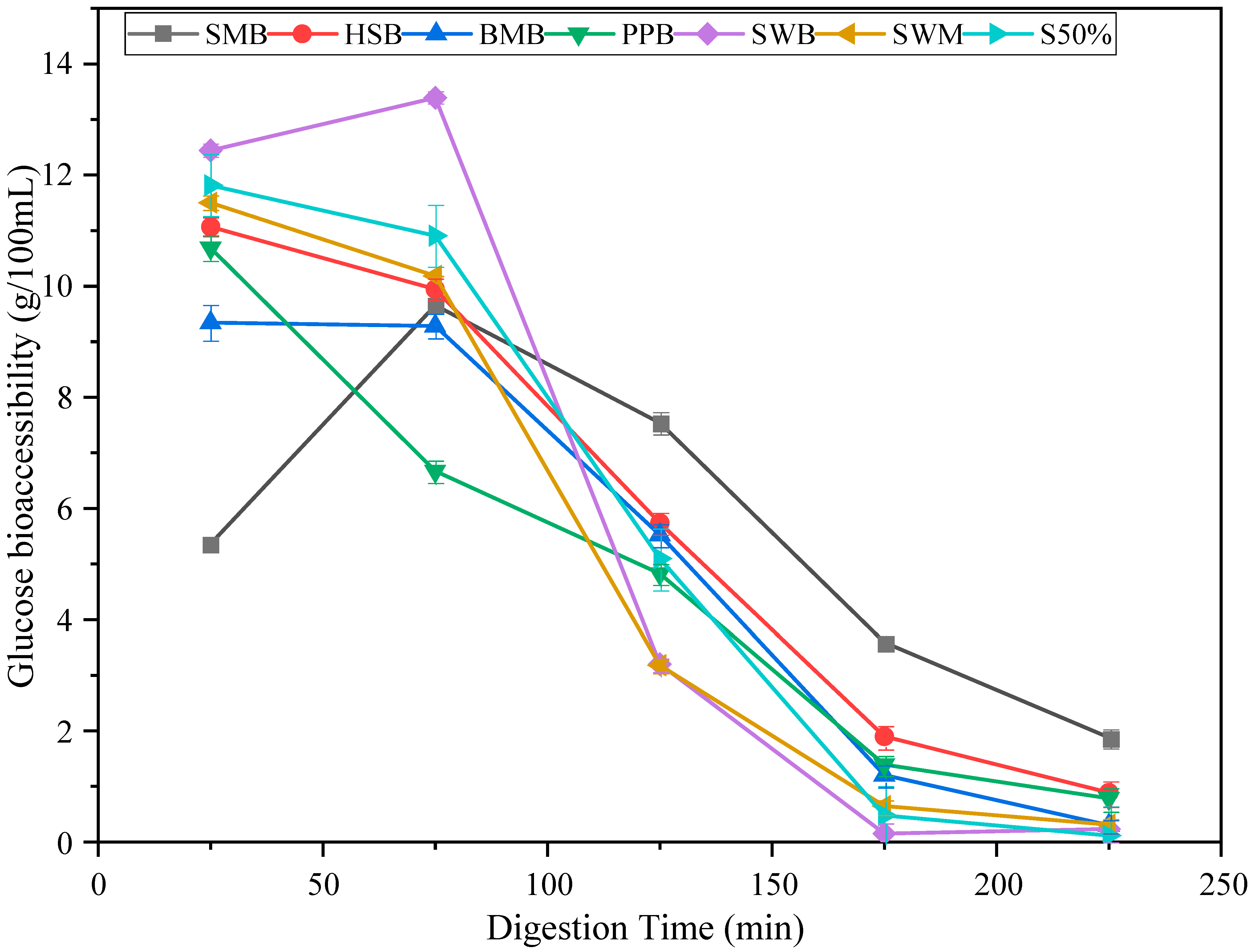
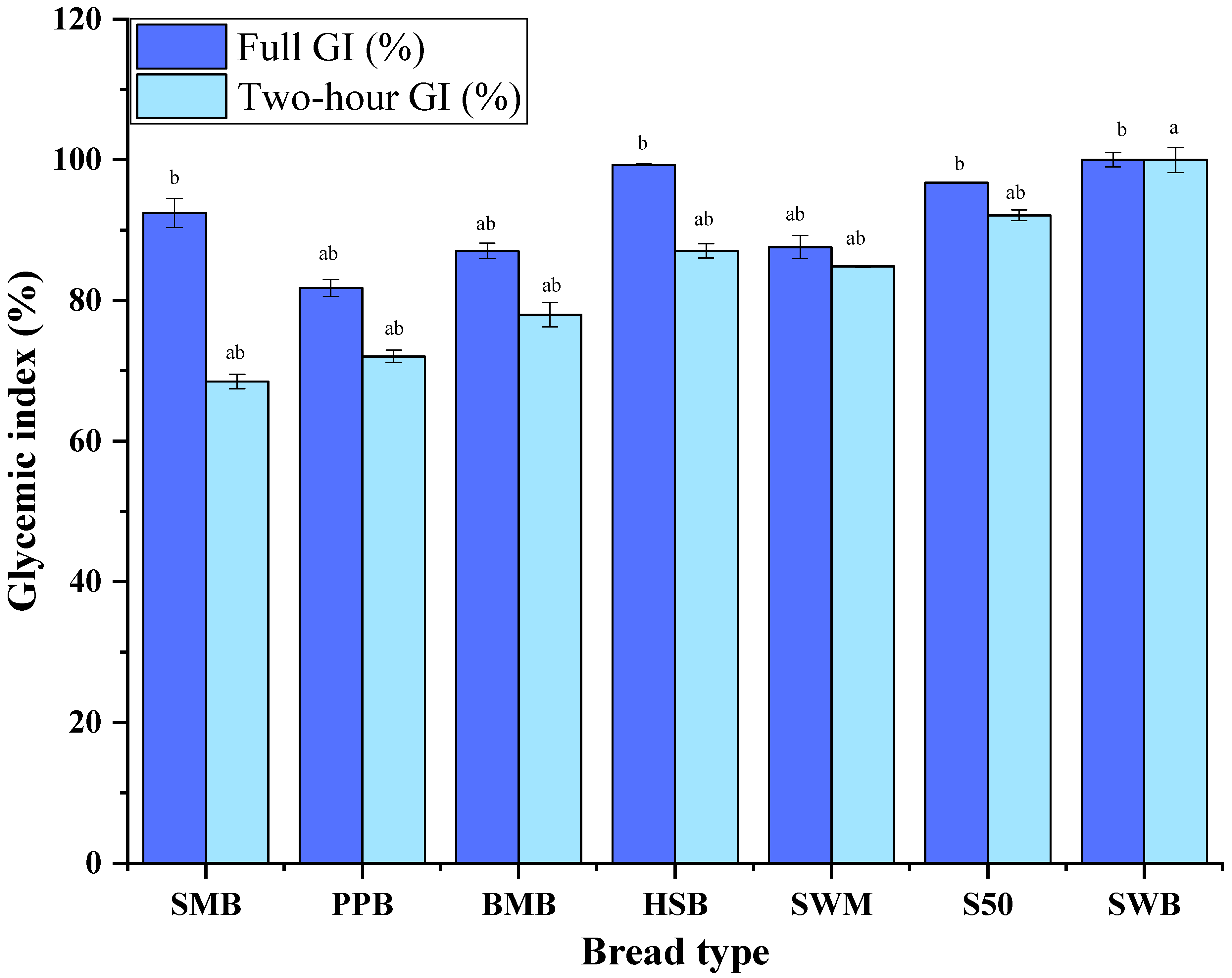
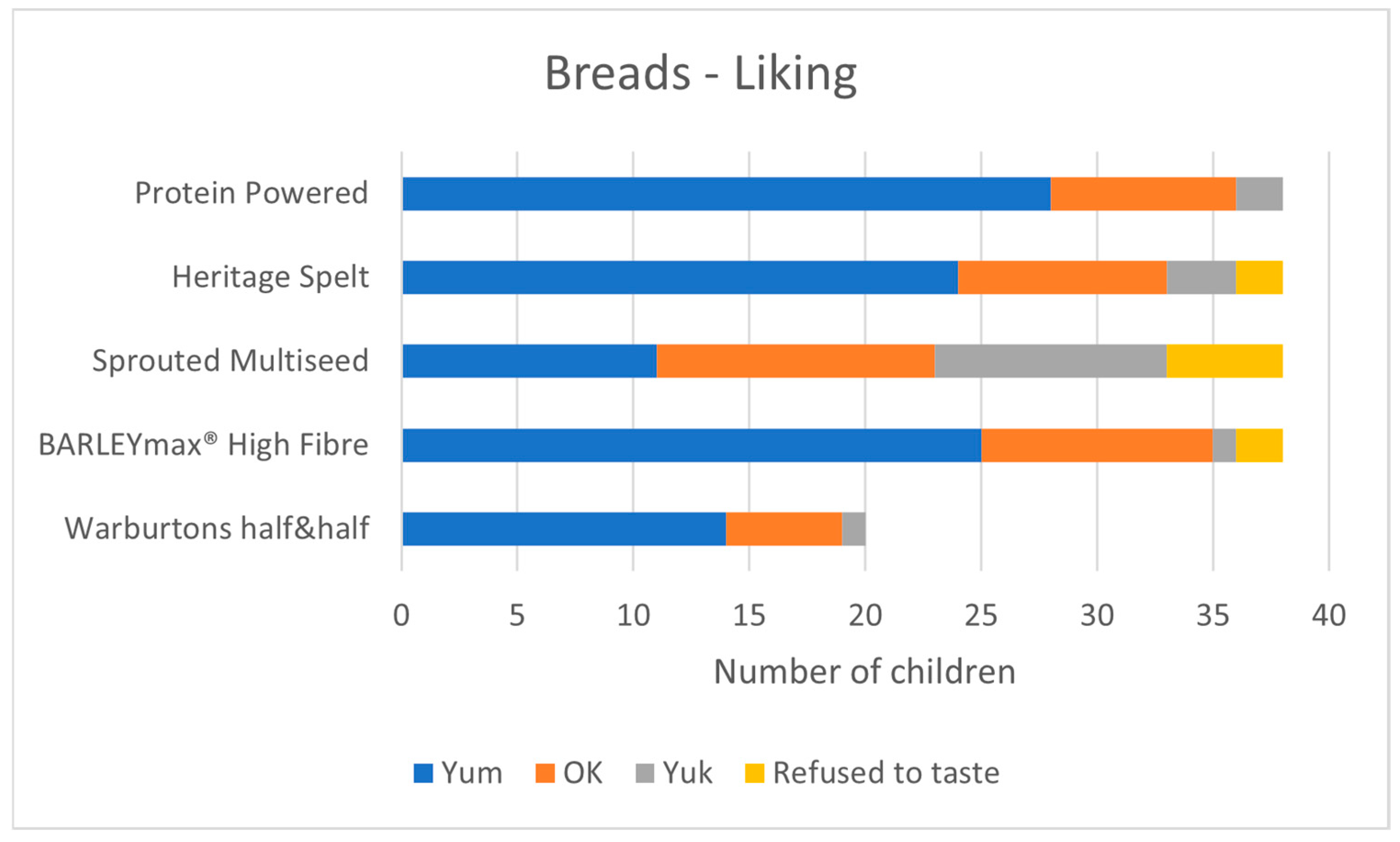
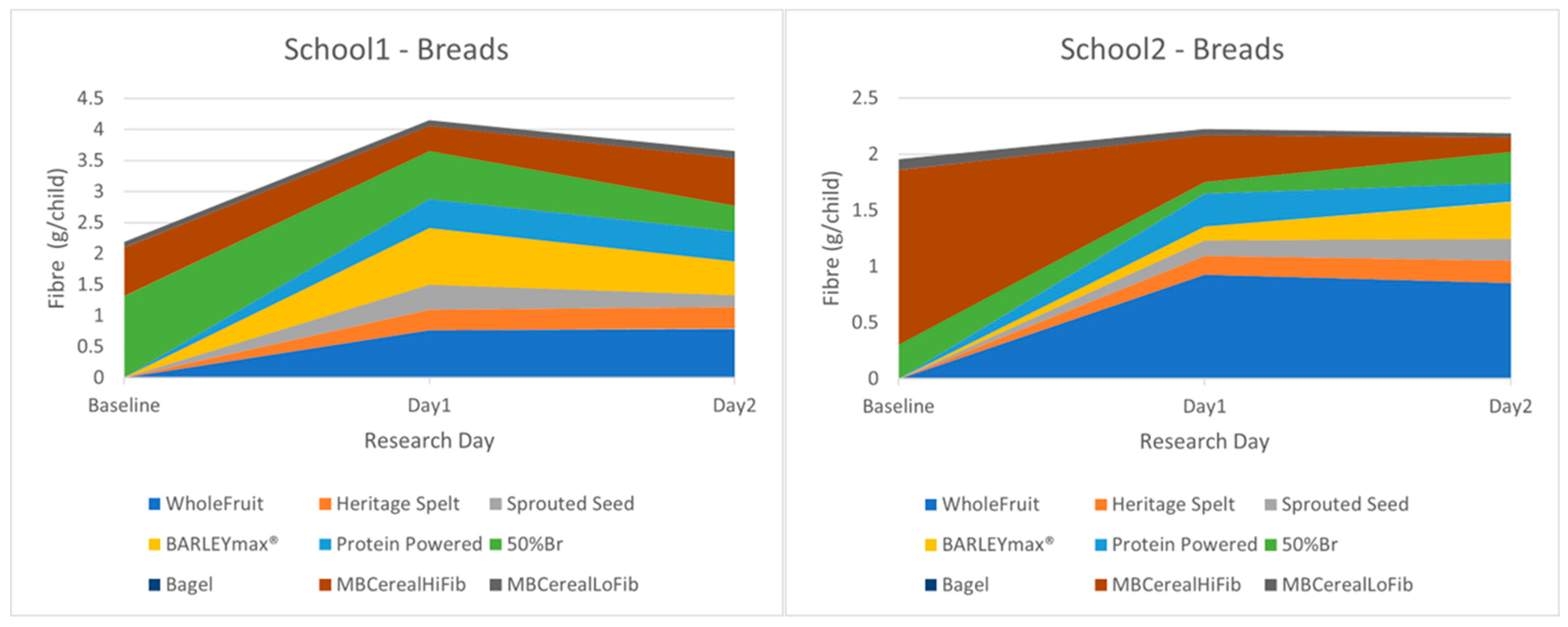
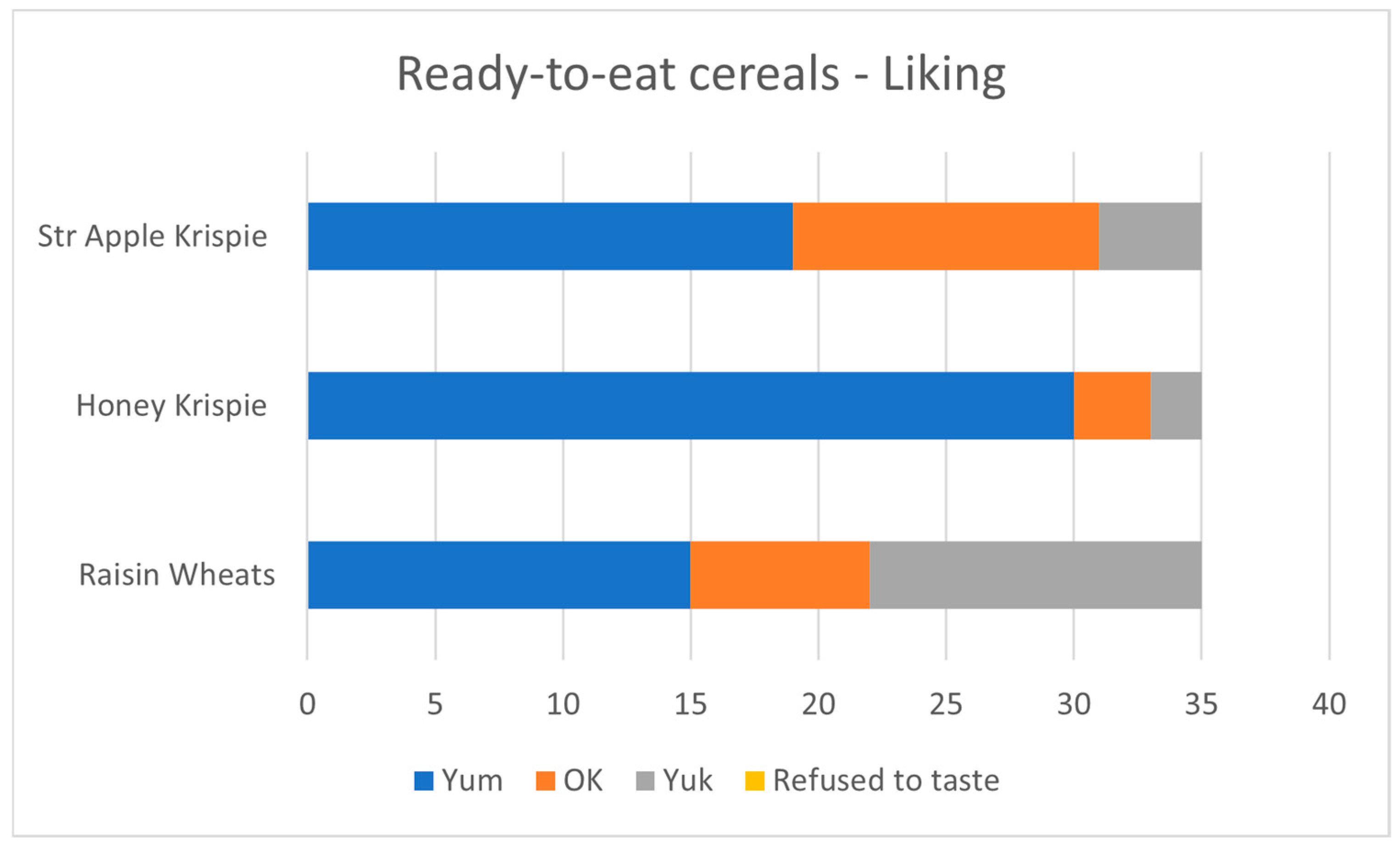

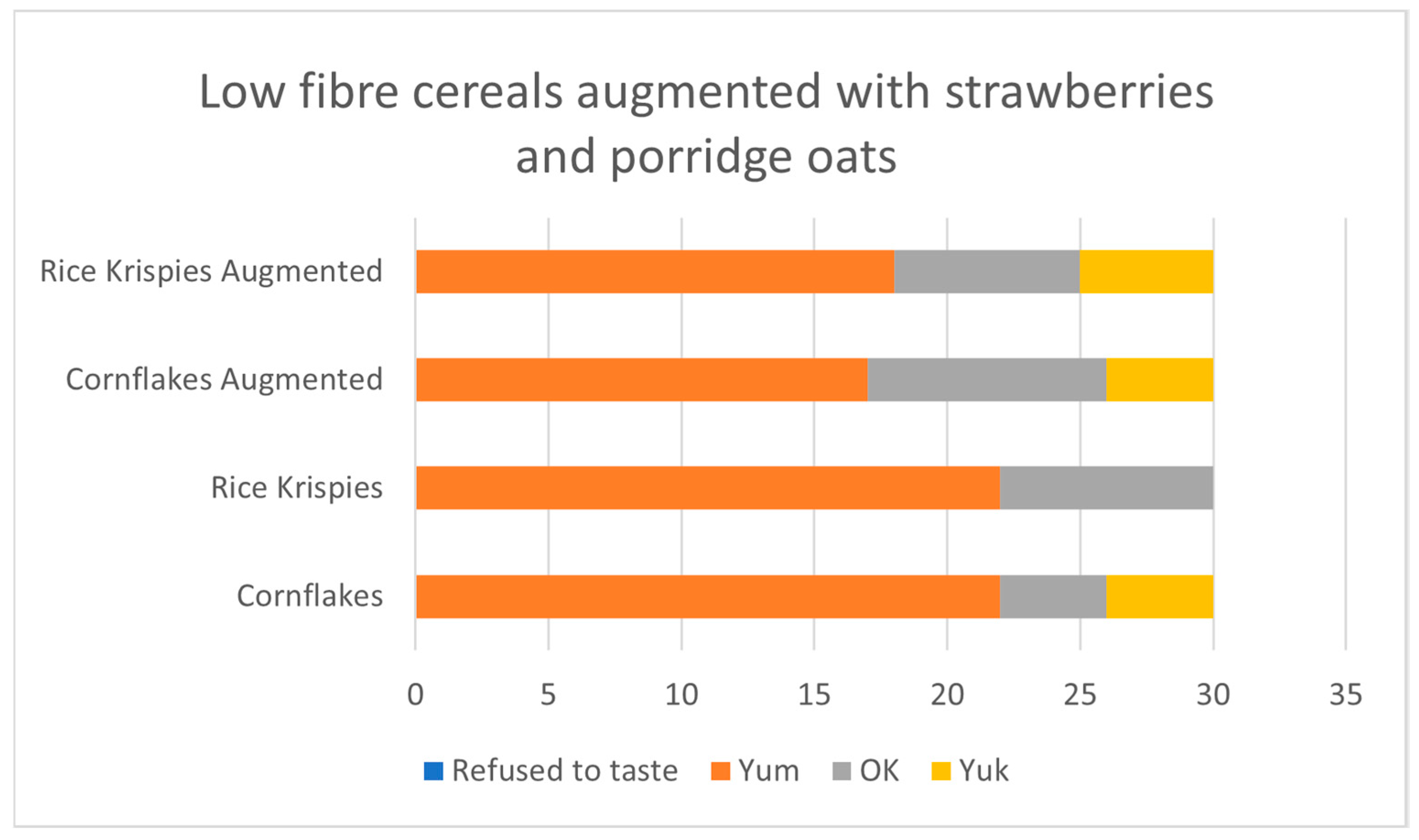
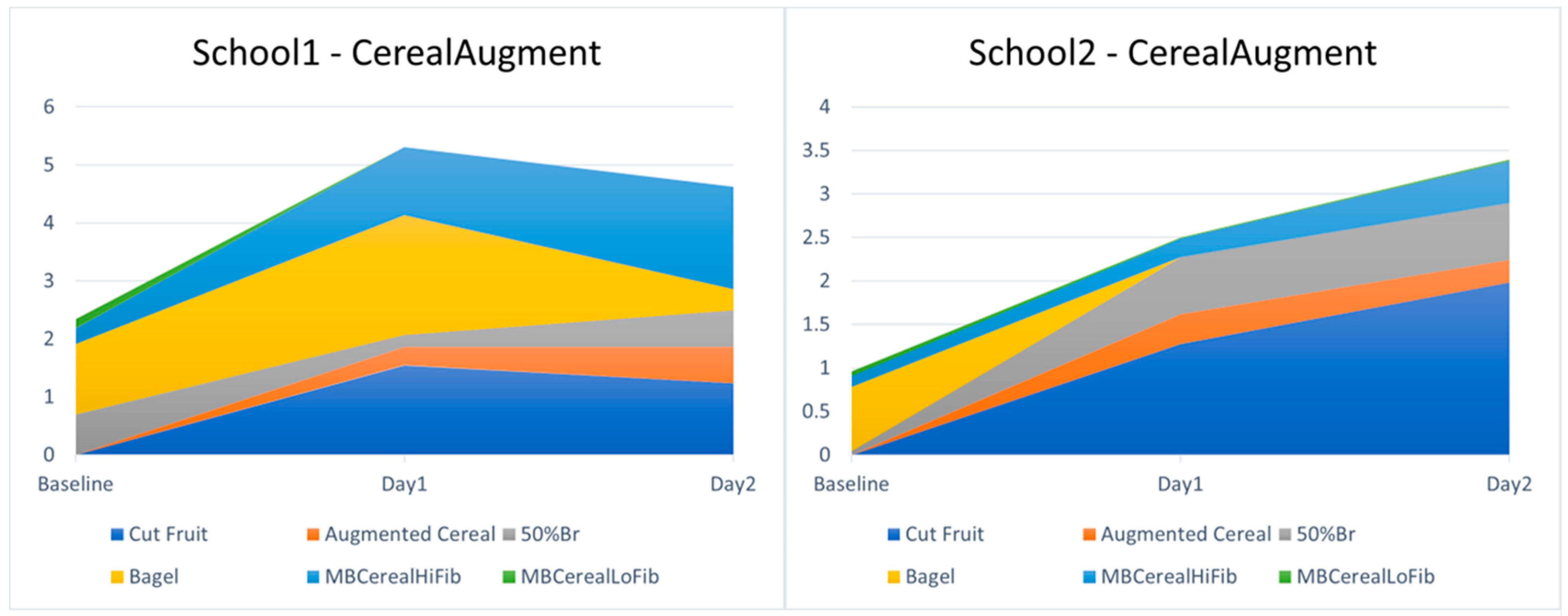
| Mean Fibre Chosen (g/Child Present) | Baseline | Day 1 Total | Day 2 Total | Day 1 and 2 | Mean Change |
|---|---|---|---|---|---|
| Week 1, School 1 | 2.19 | 4.15 | 3.66 | 3.905 | 1.715 |
| Week 1, School 2 | 1.95 | 2.22 | 2.19 | 2.205 | 0.255 |
| Week 2, School 1 | 2.25 | 4.06 | 4.73 | 4.395 | 2.145 |
| Week 2, School 2 | 1.54 | 6.22 | 3.36 | 4.79 | 3.25 |
| Week 3, School 1 | 2.34 | 5.31 | 4.62 | 4.965 | 2.625 |
| Week 3, School 2 | 0.96 | 2.5 | 3.39 | 2.945 | 1.985 |
| Average (mean) | 1.872 | 4.077 | 3.66 | 3.867 | 1.995 |
Disclaimer/Publisher’s Note: The statements, opinions and data contained in all publications are solely those of the individual author(s) and contributor(s) and not of MDPI and/or the editor(s). MDPI and/or the editor(s) disclaim responsibility for any injury to people or property resulting from any ideas, methods, instructions or products referred to in the content. |
© 2025 by the authors. Licensee MDPI, Basel, Switzerland. This article is an open access article distributed under the terms and conditions of the Creative Commons Attribution (CC BY) license (https://creativecommons.org/licenses/by/4.0/).
Share and Cite
Wilkinson, N.M.; Niaz, T.; Tann, E.; Croden, F.; Boyle, N.B.; Mackie, A.; Dye, L. Novel Fibre-Rich Breads Yield Improved Glucose Release Curves and Are Well Accepted by Children in Primary School Breakfast Clubs. Nutrients 2025, 17, 308. https://doi.org/10.3390/nu17020308
Wilkinson NM, Niaz T, Tann E, Croden F, Boyle NB, Mackie A, Dye L. Novel Fibre-Rich Breads Yield Improved Glucose Release Curves and Are Well Accepted by Children in Primary School Breakfast Clubs. Nutrients. 2025; 17(2):308. https://doi.org/10.3390/nu17020308
Chicago/Turabian StyleWilkinson, Nicholas M., Taskeen Niaz, Eloise Tann, Fiona Croden, Neil B. Boyle, Alan Mackie, and Louise Dye. 2025. "Novel Fibre-Rich Breads Yield Improved Glucose Release Curves and Are Well Accepted by Children in Primary School Breakfast Clubs" Nutrients 17, no. 2: 308. https://doi.org/10.3390/nu17020308
APA StyleWilkinson, N. M., Niaz, T., Tann, E., Croden, F., Boyle, N. B., Mackie, A., & Dye, L. (2025). Novel Fibre-Rich Breads Yield Improved Glucose Release Curves and Are Well Accepted by Children in Primary School Breakfast Clubs. Nutrients, 17(2), 308. https://doi.org/10.3390/nu17020308






